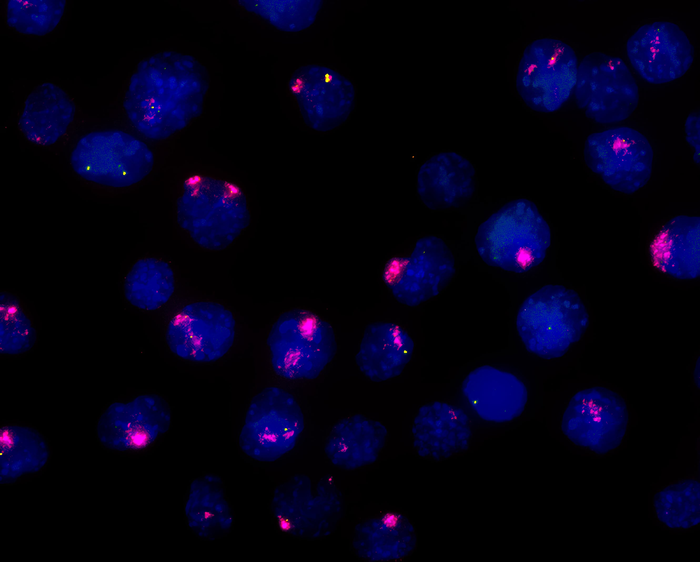Two X chromosomes are actually one too many. Female mammalian cells hence switch off one of them – but only when the cells start to specialize into tissues. A Berlin research team has now discovered how cells “count” their chromosomes and at the same time sense which stage of development they are in.

Credit: MPI f. Molecular Genetics/ T. Schwämmle
Two X chromosomes are actually one too many. Female mammalian cells hence switch off one of them – but only when the cells start to specialize into tissues. A Berlin research team has now discovered how cells “count” their chromosomes and at the same time sense which stage of development they are in.
The cells of female mammals have a dosage problem, because they have twice as many X chromosomes as are needed in the body. Consequently, one of them is randomly selected and switched off already during early embryonic development. The Xist gene awakens and produces hundreds of RNA molecules, encasing one X chromosome and making it shrink into a small lump.
But how does the cell know to turn off one chromosome at a given time – but only if there are two of them? A research team led by Lise Meitner Group Leader Edda Schulz at the Max Planck Institute for Molecular Genetics (MPIMG) found the answer to this decades-old puzzle in mouse stem cells and published their results in the journal Molecular Cell.
A new genetic circuit
The Berlin scientists identified a genetic circuit that receives information about the developmental stage of the cell and passes it on to the Xist gene. “We found the regulatory region that senses whether the cell has left its stem cell state,” says Edda Schulz.
The newly discovered gene switch, dubbed “Xert”, is a member of the “enhancer” family of regulatory sequences. It is not sufficient to trigger the deactivation program on its own. Xist will only respond to the developmental cues if it is freely accessible and not blocked by other factors, which is the case when two X chromosomes are present in the cell. Only when both conditions are met, Xist can silence the “surplus” X chromosome.
The DNA elements around Xist process information from different sources, almost like a computer, says Schulz: “A cell has programs that can be started and stopped. But unlike a machine made of wires and silicon, its circuits are made of molecules that dock to one another or are created by chemical reactions.”
Gaining insight by disruption
“Our goal was to trace the genetic circuits without knowing the schematics,” says Rutger Gjaltema, scientist in Schulz’s lab and first author of the paper. “In the end, we got a fairly complete picture of the regulatory landscape of Xist.”
In an initial screening experiment, the scientists determined 138 DNA segments on the X chromosome that appeared to be involved in signaling around the Xist gene in some way. For each of the segments, they designed a snippet of DNA that could individually target and knock out the potential gene switches. The researchers put the snippets into virus-like particles, infected cells with them, and observed in which cases Xist RNA production was enhanced or impaired.
“We tracked down numerous Xist regulators that we already knew, which was a good sign because it confirmed that our approach was working,” says Till Schwämmle, another scientist on Schulz’s team and also first author of the paper. “More exciting, of course, was that a number of completely unknown sequences turned up in the analyses.”
Division of labor in space
To investigate the function of the new sequences, Gjaltema and Schwämmle compared their activity in stem cells, developing cells, and cells with two or only one X chromosome. They noticed that there appears to be a division of labor between the genetic switches and a striking spatial separation.
The first switch is located in the immediate vicinity of Xist and its starting sequence. It only flips when a double dose of X-linked encoded enzymes is present. These enzymes appear to mediate the degradation of factors that block sections near Xist. Once there is enough enzyme, the gene gets accessible to the Xert enhancer signals. However, with only one X chromosome, there is too little of it and Xist remains blocked and unable to do its job.
The second switch is not located near Xist, Schulz explains: “Similar to other developmental genes, the enhancer is relatively far away from its target gene. The DNA has to bend into a loop in order to make contact with the gene,” the scientist says. Together with Stefan Mundlos’ research group at the MPIMG, her team studied the three-dimensional structure of the DNA around the Xist gene. “We show that signals far away from each other on the DNA strand are integrated.”
“The two signaling pathways are linked”, Schulz says. “The region in close proximity to Xist arms the mechanism, acting like an on-off switch. Then, the enhancer can pull the trigger when the cell has developed far enough.”
A model for other developmental genes
The new discoveries provide clues for years of further study to fully elucidate X chromosome inactivation, Schulz says. However, while the process controlled by Xist is unique in the animal kingdom, the genetic control mechanisms are not. Schulz believes that Xist regulation can also be used to better understand other developmental genes: “X inactivation is a fascinating system in itself, but most importantly, it’s a very valuable model to better understand the regulatory relationships in our genome.”
Journal
Molecular Cell
DOI
10.1016/j.molcel.2021.11.023
Method of Research
Experimental study
Article Title
Distal and proximal cis-regulatory elements sense X chromosome dosage and developmental state at the Xist locus
Article Publication Date
14-Dec-2021




